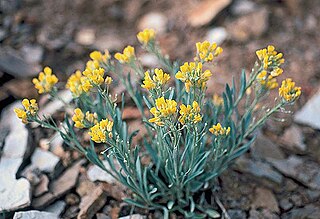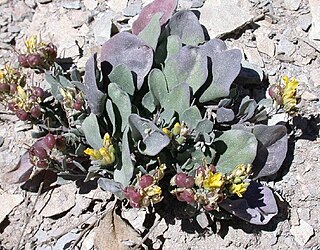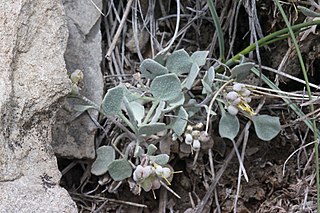
Brassicaceae or Cruciferae is a medium-sized and economically important family of flowering plants commonly known as the mustards, the crucifers, or the cabbage family. Most are herbaceous plants, while some are shrubs. The leaves are simple, lack stipules, and appear alternately on stems or in rosettes. The inflorescences are terminal and lack bracts. The flowers have four free sepals, four free alternating petals, two shorter free stamens and four longer free stamens. The fruit has seeds in rows, divided by a thin wall.

Physaria fendleri is a species of flowering plant in the family Brassicaceae known by several common names, including Fendler's bladderpod, popweed, and lesquerella.

Lesquerella is the former name of a genus of flowering plants in the family Brassicaceae. Recent work has shown that Lesquerella is indistinct from the genus Physaria and both genera have been united under Physaria. In addition, the former Lesquerella of the southeastern United States have been moved to the genus Paysonia since 2002. The genus Lesquerella is now no longer applied to any species and is considered defunct.
Bladderpod is a common name for several plants and may refer to:

Physaria is a genus of flowering plants in the family Brassicaceae. Many species are known generally as twinpods, bladderpods, or lesquerella. They are native to the Americas, with many species endemic to western North America. They are densely hairy annual and perennial herbs often growing prostrate or decumbent, along the ground in patches or clumps. They bear inflorescences of bright yellow flowers. The fruit is often notched deeply, dividing into twin sections, giving the genus its common name.

Physaria chambersii is a species of flowering plant in the family Brassicaceae known by the common name Chambers' twinpod. It is native to the southwestern United States, where it grows in desert woodland and plateau habitat. It is a perennial herb growing from a taproot and producing a clumpy rosette of stems up to 15 centimeters long, growing erect and falling over in fruit. The plant is covered in a silver-white coat of hairs. The leaves in the rosette are rounded to oval, up to 6 centimeters long by 2 wide, and smaller, spoon-shaped leaves are located along the stems. The inflorescence is a raceme of four-petalled golden yellow flowers. The fruit is an inflated pod which may be over a centimeter long. It is notched and divided into two chambers, each containing 4 seeds.

Physaria filiformis is a rare species of flowering plant in the family Brassicaceae known by the common names Missouri bladderpod and limestone glade bladderpod. It is native to Missouri and Arkansas in the United States. It was federally listed as an endangered species in 1987 and it was downlisted to threatened status in 2003. P. filiformis remains listed as an endangered species at the state level in Missouri.

Physaria obcordata is a rare species of flowering plant in the family Brassicaceae known by the common name Dudley Bluffs twinpod. It is similar in appearance to the more common Piceance twinpod, but can be distinguished by looking at the leaves through a hand lens. The Piceance twinpod, Physaria acutifolia has stellate hairs when viewed through a hand lens while Physaria ocordata has markings that look like a satellite dish, or a circle with a dot in the middle. It is endemic to Colorado, where it is found only in the Piceance Basin in Rio Blanco County. It is threatened by the loss and degradation of its habitat. It is a federally listed threatened species of the United States.
Physaria parviflora is a species of flowering plant in the family Brassicaceae known by the common names Piceance bladderpod and frosty bladderpod. It is endemic to Colorado in the United States, where it occurs in Garfield, Mesa, and Rio Blanco Counties.

Physaria bellii is a species of flowering plant in the family Brassicaceae known by the common names Bell's twinpod and Front Range twinpod. It is endemic to Colorado in the United States.

Physaria tenella is a species of flowering plant in the family Brassicaceae known by the common names Moapa bladderpod and slender bladderpod. It is native to western North America from Utah to Sonora, where it grows mainly in desert habitat. This is an annual herb producing several hairy multibranched erect to spreading stems sometimes exceeding half a meter long. The basal leaves are up to 6.5 centimeters long and sometimes toothed, and there are smaller leaves higher on the stem. The inflorescence is a raceme of flowers at the tip of the stem. The mustardlike flower has four orange to bright yellow petals each up to a centimeter long. The fruit is a plump, hairy, rounded capsule containing flat orange seeds.
Leavenworthia crassa is a species of flowering plant in the mustard family, Brassicaceae, known commonly as the fleshy-fruit gladecress. It is endemic to Alabama in the United States, where it occurs in only two counties. It is "likely one of the most imperiled plant species in the Southeast," and the United States Fish and Wildlife Service issued a final rule listing it as an endangered species in 2014.

Physaria kingii is a species of flowering plant in the family Brassicaceae known by the common name King bladderpod. It is native to western North America from Utah to Baja California, where it grows in dry and rocky habitat, such as deserts and adjacent mountain slopes. This is a perennial herb growing a small, hairy stem from a caudex. The leaves form a patch or rosette around the caudex, each up to 6 centimeters long and round, oval, diamond, or spoonlike in shape. The inflorescence is an erect or mostly upright raceme of bright yellow mustardlike flowers. The fruit is a hairy capsule under a centimeter long suspended on a short, often curvy pedicel.

Physaria parvula is a species of flowering plant in the family Brassicaceae known by the common name pygmy bladderpod. It is native to the Western United States, where it can be found in Colorado, Utah, and Wyoming.

Physaria pruinosa is a species of flowering plant in the family Brassicaceae known by the common names Pagosa Springs bladderpod and frosty bladderpod. It is native to Colorado and New Mexico in the United States.
Physaria gordonii, commonly known as Gordon's bladderpod, is a species of plant in the family Brassicaceae distributed throughout the Southwestern United States and Northern Mexico. It is a winter annual wildflower, maturing between April and June. The plant normally grows in sandy or gravel deserts. The plant has low-growing stems, with long, lanceolate leaves measuring about 4 in (10 cm). The plants flowers are in a loose, raceme cluster, and are radially symmetrical. The plant is very similar to P. fendleri.

Physaria repanda, the Indian Canyon twinpod, is a species of plant in the family Brassicaceae distributed in Utah. It is a perennial wildflower.
Physaria floribunda, the pointtip twinpod, is a member of the family Brassicaceae. It is an herbaceous perennial occurring in the United States states of Colorado, Utah, and Arizona.

Physaria ludoviciana is a species of flowering plant in the mustard family Brassicaceae, with the common names of bladder pod, silver bladderpod, louisiana bladderpod, and foothill bladderpod. It used to be Lesquerella ludoviciana which is now a synonym.

Physaria humilis, the St. Marys Peak bladderpod or Bitterroot bladderpod, is a species within the family Brassicaceae that is endemic to the Bitterroot Mountains of Montana.














